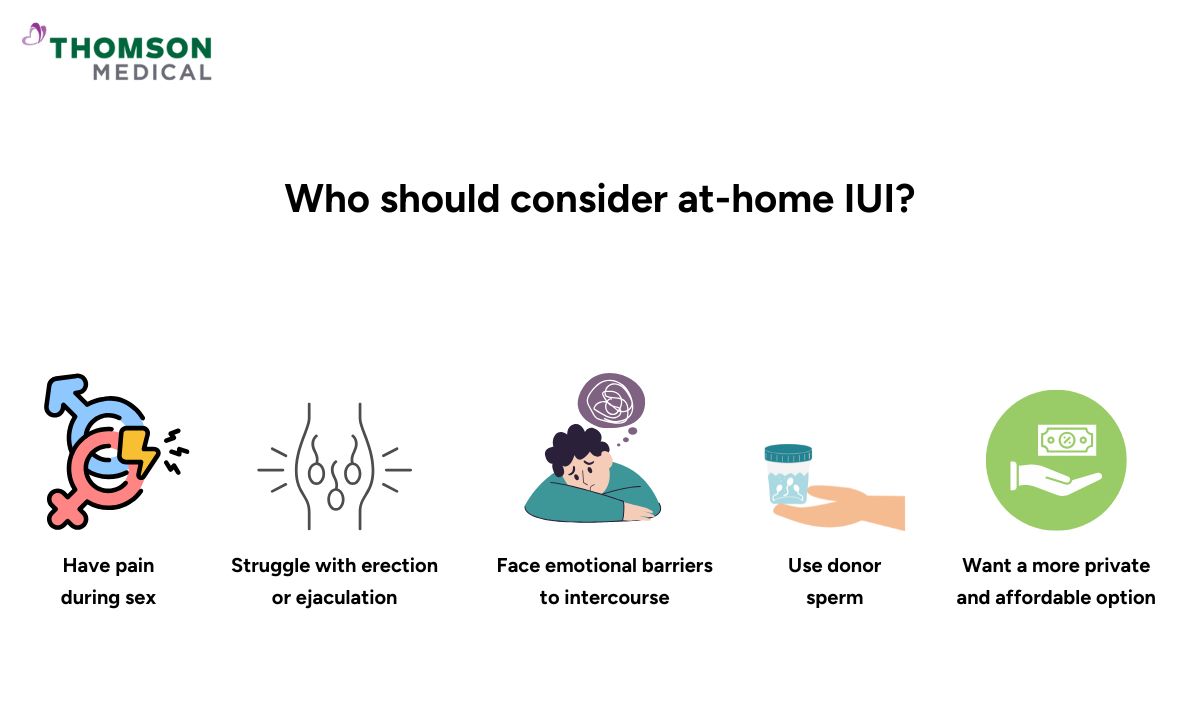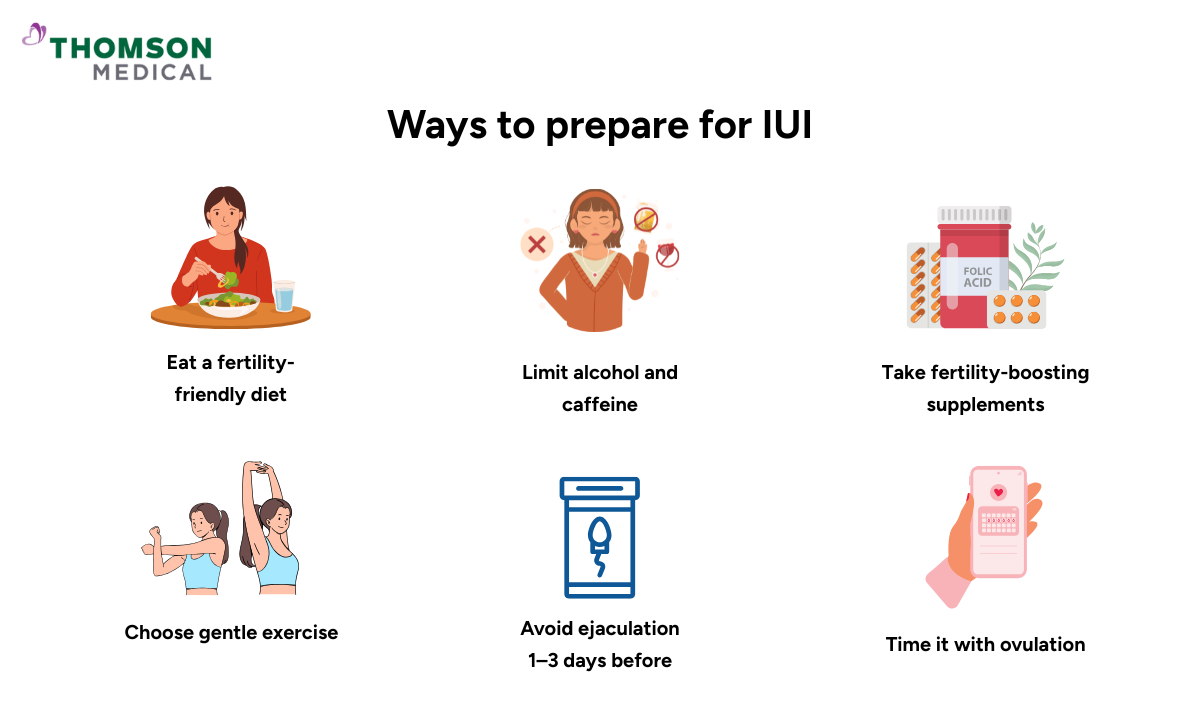Thinking about trying intrauterine insemination (IUI) in the comfort of your own home?
For some people, the idea of trying IUI at home feels more intimate, relaxed, and on their own terms. Whether you’re hoping for a little more privacy, looking to save on clinic visits, or simply exploring all your options, understanding how at-home IUI works can help you take this step with confidence and care.
What is at-home IUI?
At-home IUI, often referred to as intracervical insemination (ICI), is a form of artificial insemination that can be done in the comfort and privacy of your own home. Instead of sexual intercourse, sperm is placed directly into the vaginal canal to help increase the chances of pregnancy.
This can be done using simple tools such as a needle-free plastic syringe or a soft sperm cup (similar to a menstrual cup) that’s positioned inside the vagina to keep the sperm close to the cervix. From there, your body does the rest. The cervix naturally filters the semen, allowing healthy sperm to swim into the uterus without causing irritation.
How is IUI at home different from IUI at a clinic?
The main difference lies in where the sperm is placed and who performs the procedure.
With at-home insemination, sperm is placed into the vaginal canal close to the cervix, usually by the individual or their partner. This allows sperm to travel naturally through the cervix into the uterus.
In contrast, IUI in a clinic is performed by a healthcare professional. In this procedure, washed, high-quality sperm is inserted directly into the uterus using a thin catheter, bypassing the cervix entirely. This can help increase the chances of conception, especially for couples facing certain fertility challenges.
Who should consider at-home insemination?

At-home insemination can be a suitable option for individuals or couples who want a more private, comfortable, and flexible approach to conception. It may be especially helpful for those who:
Experience pain during sexual intercourse (dyspareunia)
Have difficulty achieving or maintaining an erection, or trouble with ejaculation during penetrative sex
Face emotional or psychological barriers to intercourse, such as past trauma
Are using sperm donor for conception
Prefer a more affordable and discreet alternative to in-clinic procedures
While at-home insemination can work well in some situations, it’s still important to speak with a healthcare professional first, especially if there are known fertility issues.
How should I prepare for at-home insemination?

A little preparation and at-home IUI tips can help improve your chances of success with at-home insemination. Here are some key tips:
Eat a fertility-friendly diet:
Include fresh fruits and vegetables, lean protein, healthy fats, and whole grains.
Limit alcohol and caffeine:
Excess intake may reduce fertility and lower conception chances.
Take fertility-boosting supplements:
Folic acid, vitamin D, and omega-3 fatty acids are beneficial.
Choose gentle exercise:
Opt for yoga, swimming, or walking instead of strenuous workouts.
Avoid ejaculation 1–3 days before:
This helps ensure a higher sperm count and volume for insemination.
Time it with ovulation:
Aim for the day before ovulation or within 48 hours after. Use an ovulation cycle tracker for accuracy.
Step-by-step guide to home insemination
Collecting and preparing the sperm sample:
Plan the insemination on the day of your LH surge or within 2–3 days after. Use an ovulation predictor kit from a pharmacy to detect the surge.
Avoid ejaculation for 2–3 days before the procedure to maximise sperm count and volume.
Have the male partner ejaculate into a sterile collection cup or container.
Do not use lubricants, as they can affect sperm movement.
Keep the semen sample at room temperature and use it within one hour.
If you're using frozen donor sperm, make sure to follow the cryobank’s thawing instructions carefully.
Using a syringe or insemination kit:
Prepare the syringe: Push out all air, then draw in the semen.
Hold the syringe tip upward, tap gently to release air bubbles, and push the plunger until a drop appears at the tip.
Positioning and technique for maximum success:
Lie comfortably, preferably with hips raised or on your side.
Gently insert the syringe or catheter into the vagina, placing the tip near the cervix.
Slowly inject the sperm to coat the outside of the cervix.
If comfortable, clitoral stimulation to orgasm may help the cervix become more receptive to sperm.
Post-insemination care:
Remain lying down for 10–30 minutes before moving around.
Avoid strenuous activity immediately after the procedure.
Risks and limitations of at-home IUI
While at-home IUI can be a more private and affordable way to try for a baby, it does come with certain risks and limitations:
Unscreened donor sperm:
If using donor sperm outside of a licensed clinic, it may not be tested for sexually transmitted infections (STIs) or inherited genetic conditions.
Legal uncertainties:
Without proper paperwork, there may be disputes over legal parenthood. Licensed clinics typically handle this issue to protect all parties.
Lower success rates:
Compared to in-clinic IUI, at-home methods can be less effective, especially for those who are older or facing fertility challenges—potentially delaying treatment that could help sooner.
If you’re considering at-home insemination, you can request an appointment with us and our fertility specialists for personalised guidance and support.
What are the success rates for at-home insemination?
In-clinic IUI generally offers higher success rates because the procedure is performed in a controlled, medical environment with carefully prepared sperm. At home, there are more variables, such as timing, sample handling, and technique, that can affect the outcome.
That said, research has shown promising results. One study found that participants who tried at-home insemination achieved over a 40% success rate, making it a viable option for many individuals and couples, especially when timed correctly and performed with proper preparation.
Our fertility specialists
Loading...
FAQ
Can you perform IUI at home?
Yes. At-home IUI is possible using an insemination kit. However, success depends on timing, correct use of the kit, and your reproductive health. Fertility clinics generally have higher success rates because the procedure is done in a controlled environment with professionally prepared sperm.
Can sperm be collected at home for IUI?
Yes. Sperm can be collected at home for IUI, but clinics usually recommend collection in a designated room at the clinic or hospital. If collected at home, the sample should be kept at body temperature and used within one hour to maintain sperm quality.
How can I make sure my insemination works at home?
To improve your chances of success:
Track ovulation and time insemination during your fertile window; doing it more than once in this period may help.
Use proper technique: sterilise the syringe and collection cup, and place sperm close to the cervix.
Maintain a healthy lifestyle: eat a balanced diet, exercise moderately, and avoid smoking, excessive alcohol, or caffeine.
Can I pee after at-home insemination?
Yes. The urinary tract is separate from the reproductive tract, so urinating will not affect the sperm’s ability to reach the uterus. However, some doctors suggest waiting at least 30 minutes after insemination before using the bathroom.
What is the best position for at-home insemination?
Lie on your back for 20–30 minutes with a pillow under your hips to help gravity guide the sperm towards the uterus.
What should I avoid after at-home insemination?
Avoid strenuous activity, douching, or cleaning up immediately afterward. Instead, rest and keep your hips elevated. Refrain from alcohol, hot tubs, and saunas, as they may affect fertility.
The information provided is intended for general guidance only and should not be considered medical advice. For personalised recommendations and tailored advice based on your unique situations, please consult a specialist at Thomson Medical. Request an appointment with Thomson Medical today.
For more information, contact us:
Thomson Fertility
- Paragon: 6252 7766
Thomson Specialists (Women's Health)
Request an Appointment